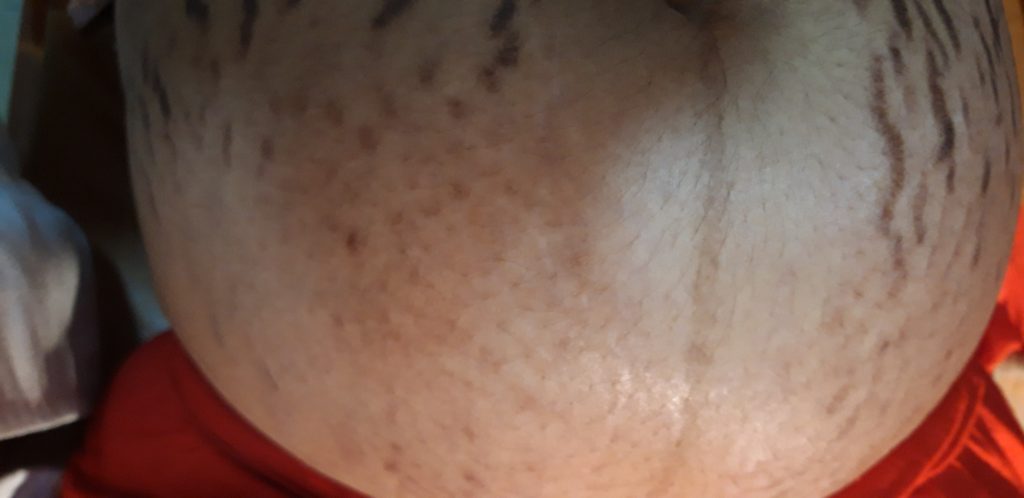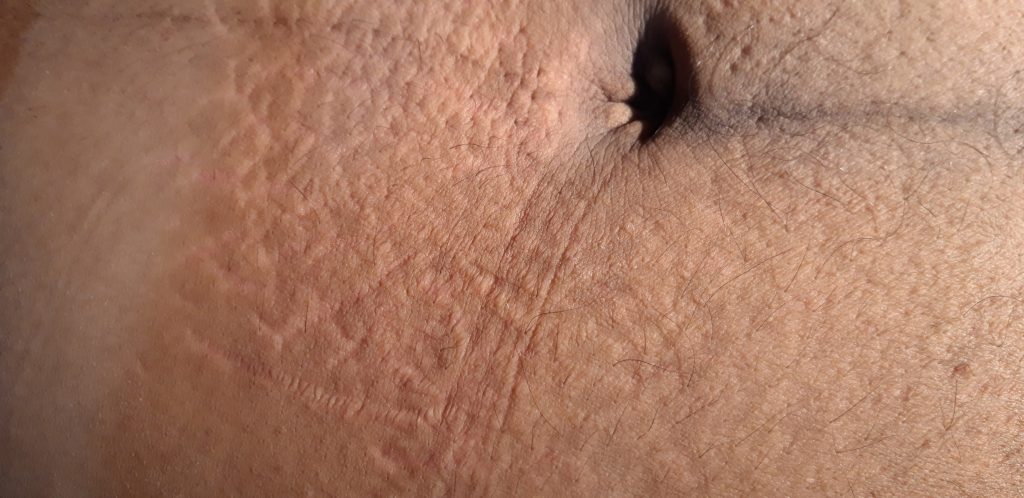POSTPARTUM STRETCH-MARKS….. PERISH, DO NOT PANIC
Stretch-marks following pregnancy and delivery, also known as – (Striae gravidarum ), is the bane of most women’s lives. In olden times scarred stomachs due to stretch –marks were considered a “Testimony “of beautiful experiences faced during motherhood. Some women
are so much concerned about the cosmetic look that
they –“Panic “ to such an extent that they are both emotionally and psychologically distressed.
More than 90 % of expecting mothers accept that stretch marks are one of the most problematic issues. A survey in Indian cities revealed that 87% of women and would-be mothers are concerned about their physical appearance during and post-delivery.
WHAT CAUSES STRETCH MARKS and ITCHING occurs due to the tearing a deep layer of skin. Tearing depends on –
-Genetic tendency
-degree of stress on the skin
-Cortisone level (cortisone weakens the elastic fibers of the skin)
-with dermal tearing, nerves respond as an itching sensation.
-Researchers identified an association between stretch marks and a variant near the ELN gene that encodes for protein elastin. Defect in the gene affects the integrity of the skin as well as cause heart defects.
It can be due to – Pregnancy, Rapid Weight gain due to an increase in muscle size, Obesity, Growth spurts during teenage, weight lifting, side effects of medicine, etc. Our skin has three main layers—
1- Epidermis- outer top layer which we see. It gives color and tone to the skin and acts as a waterproof barrier.
2- Dermis- This second layer has multiple functions. It is consists of
tough connective tis
3- sues. It has sweat glands and hair- follicles.
4- Hypodermis (Subcutaneous tissue) is the deeper layer of fat and connective tissues.
COMMON QUERIES REGARDING STRETCH- MARKS are as follows—
Q1.- Are stretch marks dangerous?
Ans-No, they look bad cosmetically but fade away with time.
Q2.- Does Losing weight is helpful to get rid of stretch marks?
Ans-Stretch marks do disappear to some extent but certainly, fade away to be noticed.
Q3.-Can one get rid of stretch marks or prevent them?
Ans-No, not hundred percent. Keeping skin hydrated with topical application of creams and oil is helpful.
Q4.-What is the first sign of stretch mark?
Ans-Initially skin appears thin, pink followed by wrinkled raised streak skin. Later it may turn red-purple-reddish brown depending on the skin color. It may itch also. Older stretch marks are white.



Q5.-Are stretch marks permanent?
Ans-Yes, but fades over time. One should not feel ashamed or over-conscious.
Q6. Why stretch-marks itches?
Ans-With dermal tearing, nerves get stimulated. These nerves respond by causing an itching sensation.
TREATMENT—
Various treatments done by Dermatologist –
-Chemical peel
-Laser therapy
-Micro derma abrasion
-Micro-needling etc.
PREVENTION—
1.Daily moisturisation of the skin during pregnancy and after delivery is helpful in two ways –firstly it reduces the dryness and itchiness often associated with stretch –marks, secondly it stimulates the skin in deeper level by increasing blood circulation to the affected area which further minimise the the appearance of stretch-marks
.Alovera helps in tissue regeneration and healing
Consistent moisturizing helps to prevent or reduce stretch- marks.
2.Maintain sufficient water levels in the body to avert problems of dry skin .Hydration helps to improve elasticity and promote the production of collagen and elastin.
- Eat plenty of green vegetables, fruits and proteins for adequate vitamins. Vitamins provide nutrients for optimum elasticity of skin.
HOW TO CHOOSE THE BEST –
The ideal option would be to choose cream which is safe, allergen- free, minimal side-effects and without
artificial fragrance. Cream should be “PARABEN-FREE” as it is suspected to cause breast cancer
Dermatologist and Aestheticians prefer oil-based cream, but
water- in – oil emollient with dual hydro-action is better
WHAT IS THE BEST TIME TO APPLY CREAM-
Anytime of the day when one can spend at least 15-20 minutes. Apply cream or oil after bath. Remove
excess water, then apply liberally and do soft massage for 15-20 minutes over mid-thighs, abdomen, arms, etc. Moist skin helps in better absorption.
One should not worry and panic about stretch-marks.

